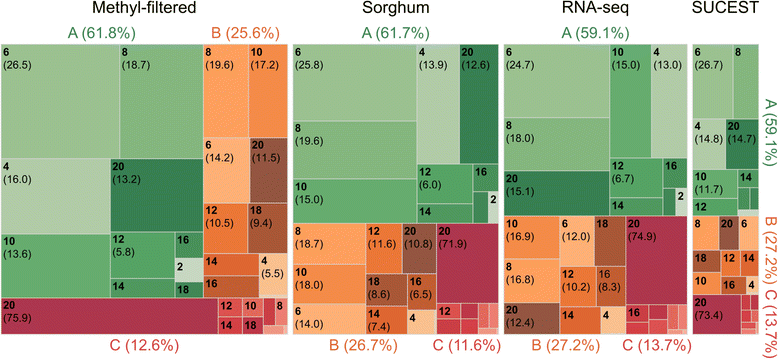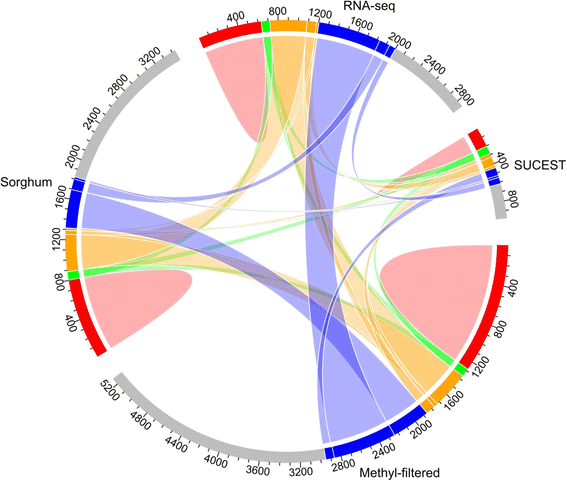GBS-based single dosage markers for linkage and QTL mapping allow gene mining for yield-related traits in sugarcane
- PMID: 28077090
- PMCID: PMC5225503
- DOI: 10.1186/s12864-016-3383-x
GBS-based single dosage markers for linkage and QTL mapping allow gene mining for yield-related traits in sugarcane
Abstract
Background: Sugarcane (Saccharum spp.) is predominantly an autopolyploid plant with a variable ploidy level, frequent aneuploidy and a large genome that hampers investigation of its organization. Genetic architecture studies are important for identifying genomic regions associated with traits of interest. However, due to the genetic complexity of sugarcane, the practical applications of genomic tools have been notably delayed in this crop, in contrast to other crops that have already advanced to marker-assisted selection (MAS) and genomic selection. High-throughput next-generation sequencing (NGS) technologies have opened new opportunities for discovering molecular markers, especially single nucleotide polymorphisms (SNPs) and insertion-deletion (indels), at the genome-wide level. The objectives of this study were to (i) establish a pipeline for identifying variants from genotyping-by-sequencing (GBS) data in sugarcane, (ii) construct an integrated genetic map with GBS-based markers plus target region amplification polymorphisms and microsatellites, (iii) detect QTLs related to yield component traits, and (iv) perform annotation of the sequences that originated the associated markers with mapped QTLs to search putative candidate genes.
Results: We used four pseudo-references to align the GBS reads. Depending on the reference, from 3,433 to 15,906 high-quality markers were discovered, and half of them segregated as single-dose markers (SDMs) on average. In addition to 7,049 non-redundant SDMs from GBS, 629 gel-based markers were used in a subsequent linkage analysis. Of 7,678 SDMs, 993 were mapped. These markers were distributed throughout 223 linkage groups, which were clustered in 18 homo(eo)logous groups (HGs), with a cumulative map length of 3,682.04 cM and an average marker density of 3.70 cM. We performed QTL mapping of four traits and found seven QTLs. Our results suggest the presence of a stable QTL across locations. Furthermore, QTLs to soluble solid content (BRIX) and fiber content (FIB) traits had markers linked to putative candidate genes.
Conclusions: This study is the first to report the use of GBS for large-scale variant discovery and genotyping of a mapping population in sugarcane, providing several insights regarding the use of NGS data in a polyploid, non-model species. The use of GBS generated a large number of markers and still enabled ploidy and allelic dosage estimation. Moreover, we were able to identify seven QTLs, two of which had great potential for validation and future use for molecular breeding in sugarcane.
Keywords: Allelic dosage; Molecular markers; Polyploidy; Quantitative traits; SNPs; Saccharum spp.
Figures



Similar articles
-
Mining sequence variations in representative polyploid sugarcane germplasm accessions.BMC Genomics. 2017 Aug 9;18(1):594. doi: 10.1186/s12864-017-3980-3. BMC Genomics. 2017. PMID: 28793856 Free PMC article.
-
Genotyping by sequencing for the construction of oil palm (Elaeis guineensis Jacq.) genetic linkage map and mapping of yield related quantitative trait loci.PeerJ. 2024 Jan 30;12:e16570. doi: 10.7717/peerj.16570. eCollection 2024. PeerJ. 2024. PMID: 38313025 Free PMC article.
-
Quantitative trait loci identified for sugar related traits in a sugarcane (Saccharum spp.) cultivar x Saccharum officinarum population.Theor Appl Genet. 2006 May;112(7):1306-17. doi: 10.1007/s00122-006-0233-2. Epub 2006 Mar 1. Theor Appl Genet. 2006. PMID: 16508765
-
Role of NGS and SNP genotyping methods in sugarcane improvement programs.Crit Rev Biotechnol. 2020 Sep;40(6):865-880. doi: 10.1080/07388551.2020.1765730. Epub 2020 Jun 7. Crit Rev Biotechnol. 2020. PMID: 32508157 Review.
-
Human QTL linkage mapping.Genetica. 2009 Jun;136(2):333-40. doi: 10.1007/s10709-008-9305-3. Epub 2008 Jul 31. Genetica. 2009. PMID: 18668207 Free PMC article. Review.
Cited by
-
Novel Tools for Adjusting Spatial Variability in the Early Sugarcane Breeding Stage.Front Plant Sci. 2021 Nov 18;12:749533. doi: 10.3389/fpls.2021.749533. eCollection 2021. Front Plant Sci. 2021. PMID: 34868135 Free PMC article.
-
Agro-Morphological, Yield, and Genotyping-by-Sequencing Data of Selected Wheat (Triticum aestivum) Germplasm From Pakistan.Front Genet. 2021 Apr 13;12:617772. doi: 10.3389/fgene.2021.617772. eCollection 2021. Front Genet. 2021. PMID: 34163518 Free PMC article. No abstract available.
-
Multiple QTL Mapping in Autopolyploids: A Random-Effect Model Approach with Application in a Hexaploid Sweetpotato Full-Sib Population.Genetics. 2020 Jul;215(3):579-595. doi: 10.1534/genetics.120.303080. Epub 2020 May 5. Genetics. 2020. PMID: 32371382 Free PMC article.
-
Development of an Axiom Sugarcane100K SNP array for genetic map construction and QTL identification.Theor Appl Genet. 2019 Oct;132(10):2829-2845. doi: 10.1007/s00122-019-03391-4. Epub 2019 Jul 18. Theor Appl Genet. 2019. PMID: 31321474
-
A genome-wide association study identified loci for yield component traits in sugarcane (Saccharum spp.).PLoS One. 2019 Jul 18;14(7):e0219843. doi: 10.1371/journal.pone.0219843. eCollection 2019. PLoS One. 2019. PMID: 31318931 Free PMC article.
References
-
- D’Hont A, Glaszmann JC. Sugarcane genome analysis with molecular markers, a first decade of research. Proc Int Soc Sugar Cane Technol. 2001;24:556–9.
-
- D’Hont A, Ison D, Alix K, Roux C, Glaszmann JC. Determination of basic chromosome numbers in the genus Saccharum by physical mapping of ribosomal RNA genes. Genome. 1998;41:221–5. doi: 10.1139/gen-41-2-221. - DOI
Publication types
MeSH terms
Substances
LinkOut - more resources
Full Text Sources
Other Literature Sources
Miscellaneous

